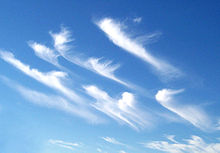Cirrus (cloud)
A cirrus or cirrus ( Latin: cirrus "lock of hair", "fringe"; abbreviation : Ci ) is a pure ice cloud at a great height. Cirrus clouds are also called feather clouds . They appear as bright white, delicate threads or narrow ribbons with a silky sheen, the edges of which are usually frayed by the high-altitude winds .
Cirrus often occur together with the cirrocumulus or cirrostratus . If they condense and large cirrostatus areas appear, this can be interpreted as a sign of a warm front .
Emergence
Cirrus clouds mostly develop from virga formations of cirrocumulus or altocumulus or from the upper part of a cumulonimbus cloud. However, they can also arise when non-uniform Cirrostratus clouds are formed through evaporation of the thinner parts. Cirrus tufts with rounded peaks often arise in a cloud-free area. Due to the typical height (8000–12000 m) at which these clouds appear, the cirrus clouds consist of fine ice crystals.
Structure and appearance
Cirrus can occur in the form of thin fibers or threads ( fibratus ) that are almost straight, irregularly curved or seemingly randomly intertwined ( intortus ). The fibers or threads are sometimes shaped like a comma and end in a hook shape or in a non-rounded tuft ( uncinus ). Cirrus also occurs in spots that are so dense that they look faintly gray when facing the sun. This type of cirrus ( spissatus ) can also obscure the sun, obscure its outlines, or even obscure it entirely.
In rarer cases, cirrus also occurs in the form of isolated, small, round tufts, which are often provided with trails ( floccus ). Small, rounded turrets or battlements that grow out of a common base are also possible ( castellanus ). The individual parts of the cirrus clouds are sometimes arranged in broad, parallel bands that seem to converge towards the horizon ( radiatus ).
At all times of the day, if Cirrus is not too close to the horizon, it looks white, even brighter than any other cloud in the same area of the sky. This is due to the low optical thickness of the clouds. If the sun is on the horizon, then cirrus is whitish, while lower clouds can be tinted yellow or orange. As soon as the sun sinks below the horizon, cirrus high in the sky turns yellow, then pink, red, and finally gray. At dawn the sequence of colors is reversed.
Cirrus near the horizon often takes on a yellowish or orange color; these hues are less noticeable in the lower cloud types. It can Halo occur -Erscheinungen. Due to the small size of the cirrus clouds, circular halos hardly appear as a closed ring.
Contrails are counted among the cirrus clouds. They are created by hot water vapor, which is created as a result of the combustion processes in jet aircraft engine turbines . Since the cold, thin air at an altitude of 7,000 to 9,000 m, at which these artificial cirrus clouds occur, cannot absorb much water vapor in gaseous form, ice needles form from the excess water vapor, and thus clouds with a composition comparable to naturally occurring cirrus clouds.
Differences from similar clouds
Cirrocumulus
Cirrus in rounded tufts or in the form of small rounded turrets or battlements that grow out of a common base can be confused with cirrocumulus of a similar appearance. The distinguishing feature is that the cirrus tufts or turrets, unlike those of the cirrocumulus cloud, have a width of more than one degree, provided that they are observed at an angle of more than 30 degrees above the horizon.
Cirrostratus
Cirrus clouds differ from cirrostratus in their disjointed structure or - if they are distributed in fields or bands - by their small horizontal extent or the small width of their contiguous parts. Cirrus near the horizon can sometimes be difficult to distinguish from cirrostratus because of the perspective effect.
Altocumulus
Cirrus in rounded tufts or in the form of small rounded turrets or battlements that grow out of a common base differs from similar looking Altocumulus in that its fine structure is silky or more fibrous than that of the Altocumulus cloud.
Altostratus
Dense cirrus spots differ from Altostratus spots in their small horizontal extent and their predominantly white color.
Web links
- Description, weather meanings , cloud subspecies from Cirren On: wolken-online.de
- Enigmatic cirrus clouds. On: Wissenschaft.de of December 2, 2003. Experiments confirm: Dust particles promote the formation of ice clouds.




